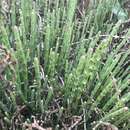fi
nimet breadcrumb-navigoinnissa


This species has generally been called Salicornia europaea by North American authors, but that name refers to a diploid European species that does not occur in North America.
The earliest name that is probably referable to this species is Salicornia virginica Linnaeus, which must be typified by specimens collected by John Clayton probably from Virginia. The specimens are sterile but clearly annual, as indicated by Linnaeus in the protologue. The name was applied to an annual species by P. C. Standley (1916), but subsequently came to be misapplied to the perennial species of the east coast now treated in Sarcocornia.
Salicornia virginica (American glasswort, pickleweed) is a halophytic perennial dicot which grows in various zones of intertidal salt marshes and can be found in alkaline flats. It is native to various regions of the Northern Hemisphere including both coasts of North America from Canada to Mexico.
The plant is one of the Salicornia species being tested as biofuel crop as its seeds are composed of 32% oil, and being a halophyte, it can be irrigated with salt water.
Salicornia virginica is classified as a obligate wetland (OBL) species which means it "occurs almost always (estimated probability 99%) under natural conditions in wetlands".[1][2]
Salicornia virginica (American glasswort, pickleweed) is a halophytic perennial dicot which grows in various zones of intertidal salt marshes and can be found in alkaline flats. It is native to various regions of the Northern Hemisphere including both coasts of North America from Canada to Mexico.
The plant is one of the Salicornia species being tested as biofuel crop as its seeds are composed of 32% oil, and being a halophyte, it can be irrigated with salt water.
Salicornia virginica is classified as a obligate wetland (OBL) species which means it "occurs almost always (estimated probability 99%) under natural conditions in wetlands".
Salicorne de Virginie
La Salicorne de Virginie, Salicornia depressa, est une espèce de plantes de la famille des Amaranthaceae que l'on ne rencontre qu'en Amérique du Nord.
C'est une plante comestible, crue en salade, ou cuite en accompagnement[2]
Cette espèce a été décrite pour la première fois en 1916 par le botaniste américain Paul Carpenter Standley (1884-1963). Elle était autrefois confondue avec la Salicorne d'Europe (Salicornia europaea)[3].
Synonyme: Salicornia virginica
Salicorne de Virginie
La Salicorne de Virginie, Salicornia depressa, est une espèce de plantes de la famille des Amaranthaceae que l'on ne rencontre qu'en Amérique du Nord.
Salicornia depressa là loài thực vật có hoa thuộc họ Dền. Loài này được Standl. miêu tả khoa học đầu tiên năm 1916.[1]
Salicornia depressa là loài thực vật có hoa thuộc họ Dền. Loài này được Standl. miêu tả khoa học đầu tiên năm 1916.